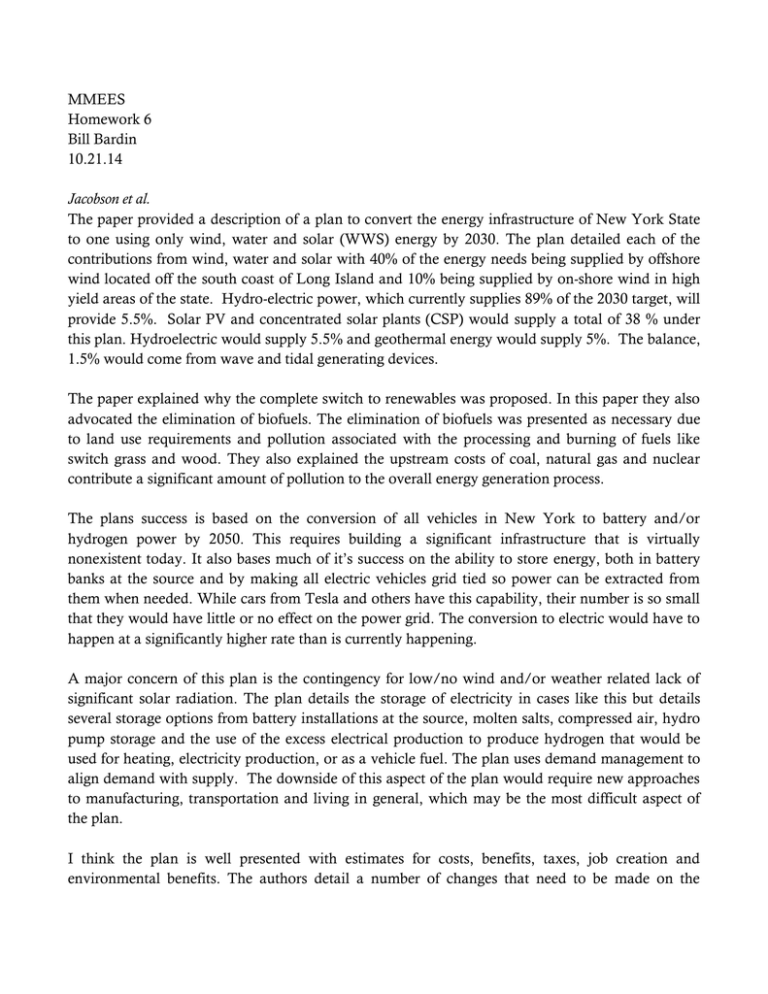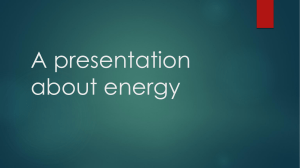MMEES Homework 6 Bill Bardin 10.21.14
advertisement

MMEES Homework 6 Bill Bardin 10.21.14 Jacobson et al. The paper provided a description of a plan to convert the energy infrastructure of New York State to one using only wind, water and solar (WWS) energy by 2030. The plan detailed each of the contributions from wind, water and solar with 40% of the energy needs being supplied by offshore wind located off the south coast of Long Island and 10% being supplied by on-shore wind in high yield areas of the state. Hydro-electric power, which currently supplies 89% of the 2030 target, will provide 5.5%. Solar PV and concentrated solar plants (CSP) would supply a total of 38 % under this plan. Hydroelectric would supply 5.5% and geothermal energy would supply 5%. The balance, 1.5% would come from wave and tidal generating devices. The paper explained why the complete switch to renewables was proposed. In this paper they also advocated the elimination of biofuels. The elimination of biofuels was presented as necessary due to land use requirements and pollution associated with the processing and burning of fuels like switch grass and wood. They also explained the upstream costs of coal, natural gas and nuclear contribute a significant amount of pollution to the overall energy generation process. The plans success is based on the conversion of all vehicles in New York to battery and/or hydrogen power by 2050. This requires building a significant infrastructure that is virtually nonexistent today. It also bases much of it’s success on the ability to store energy, both in battery banks at the source and by making all electric vehicles grid tied so power can be extracted from them when needed. While cars from Tesla and others have this capability, their number is so small that they would have little or no effect on the power grid. The conversion to electric would have to happen at a significantly higher rate than is currently happening. A major concern of this plan is the contingency for low/no wind and/or weather related lack of significant solar radiation. The plan details the storage of electricity in cases like this but details several storage options from battery installations at the source, molten salts, compressed air, hydro pump storage and the use of the excess electrical production to produce hydrogen that would be used for heating, electricity production, or as a vehicle fuel. The plan uses demand management to align demand with supply. The downside of this aspect of the plan would require new approaches to manufacturing, transportation and living in general, which may be the most difficult aspect of the plan. I think the plan is well presented with estimates for costs, benefits, taxes, job creation and environmental benefits. The authors detail a number of changes that need to be made on the legislative level for the plan to exceed. I think the goal of the plan is an admirable target but getting there will require more than just coordination among the residents of New York State. Unfortunately, New York cannot be isolated from the surrounding states, or from Canadian power generation and use for that matter. It is a complex problem that will require a comprehensive national, if not North American energy policy. There are enough examples of energy policies from around the world that we should be able to avoid many of the pitfalls they have experienced. Burger The Fraunhofer Institute presentation details electrical production in Germany from all sources, solar, wind, coal, hydro, biomass, and uranium for the first 7 months of 2014. The charts in the report show the production by source and there is a summary stacked chart showing all the sources. It is interesting to note that solar and wind, are seasonally cyclic. Solar generation is lowest in the winter and higher in the summer (as would be expected given the high latitude) but wind is the highest in the winter and lowest in the summer. Combined, there seems to be a point at which you can rely on a wind/solar combination to generate a steady amount of energy (on a monthly basis). Post Fukushima, Germany has committed to phasing out nuclear power generation. One major result from this switch is the increased dependence on coal fired power plants, which impacts greenhouse gas emissions. It is somewhat odd that there has been a reduction of the use of natural gas for generation but that is probably more of a political issue than environmental one. Germany has abundant deposits of “brown coal” which additionally compounds the problem since it is dirtier than hard coal, which is much less abundant. The overwhelming majority of the energy generated in Germany is still fossil fuel and nuclear based. Germany’s energy policy still relies heavily on fossil fuel and nuclear energy, and will not improve in the near future. With a change in renewable energy policies, Germany may be able to incentivize further growth in alternative energy sources. Germany exports electricity to several countries, which it could reduce or eliminate in order to become more self-sufficient. There could be significant economic costs to elimination electricity exports but they may be offset by the environmental benefits. With current nuclear generating capacities roughly equivalent to renewable production, Germany has a long way to go to replace them, especially if they intend to do it with renewables.


